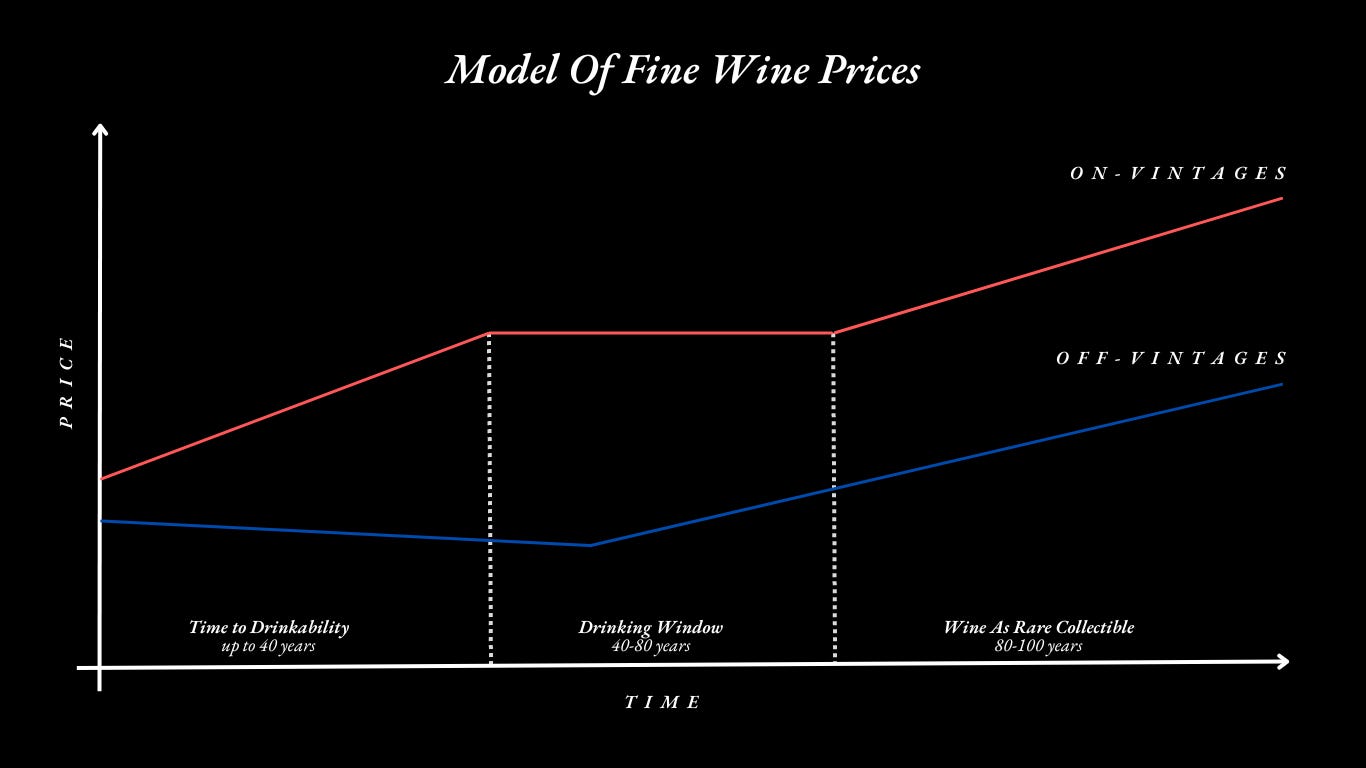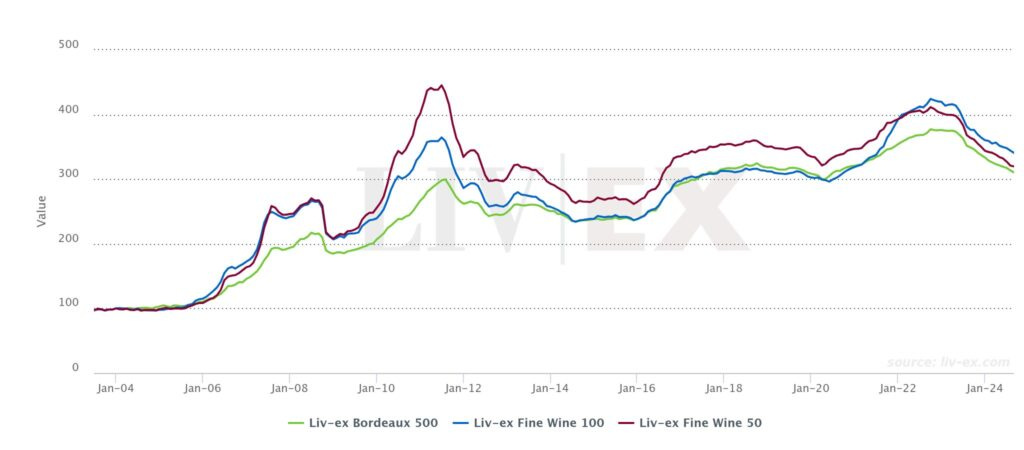In the Mood for Wine is the only weekly newsletter for the next generation of fine wine lovers and investors. And the best part? It’s free. Help keep it that way by sharing it with everyone—literally everyone!
Hello Fine Wine Lovers,
We talked about budget.
We talked about wine merchants.
Now, we’ve reached the most exciting part: choosing your wines.
Selecting the right bottles is where strategy meets passion. This is where your investing style, regional focus, and personal goals all come together. Today, we’ll guide you through the best time to buy, whether that’s during the initial release or on the secondary market. Understanding how the release cycles work and what makes certain vintages worth the wait is critical in making smart investment choices.
Alongside the free course, I’ve also created a Google Sheet, available behind a paywall (scroll to the end of the article). It’s an optional tool that organises all the essential data, metrics, and models to simplify your investment decisions. If you’d like to make things easier, or if you’d like to support my work, this is a way to do so.
Let’s dive in!
Eight Steps To Invest In Fine Wine
To access the full course, head to the homepage and click on “Fine Wine Investing Course” in the top bar.
Part 1: Released on 19th Sep 2024
Step 1: Set Clear Investment Goals
Step 2: Determine How Much You Can Afford to Invest
Step 3: Determine Your Tolerance for Risk
Part 2: Released on 3rd Oct 2024
Step 4: Determine Your Investment Style
Step 5: Choose an Investment Platform
Step 6: Fund Your Investment Account
Part 3: Today’s Session
Now, let’s get to the heart of the matter: choosing your wines and managing your collection. This part will dive deep into understanding release lifecycles, identifying key buying windows, and ensuring your collection aligns with your overall strategy.
Step 7: Pick Your Wines & Understand the Release Lifecycle. Deciding when and where to buy your wines—at release or on the secondary market—can make a huge difference. We’ll explore release cycles for key regions like Bordeaux, Burgundy, and Champagne, and help you identify strategic buying opportunities.
Step 8: Learn, Monitor, Review. Successful investors continually review their portfolios, learn from past decisions, and adjust their strategies accordingly. We’ll guide you through tools to monitor your collection and tips on recognising when to hold, sell, or buy more.
Now, we begin…
Step 7: Pick Your Wines & Understand the Release Lifecycle
By now, you have your budget and have selected your merchant(s). The next step is to decide when and where to buy your wines, which can either be at release or on the secondary market.
The process differs by region. In some areas, like Italy and Champagne, wines are sold after bottling. In regions like Bordeaux, however, you can buy wines En Primeur (EP), or as wine futures—before they’re bottled.
What is En Primeur (EP)?
En Primeur is the practice of purchasing wine before it’s bottled and released. Typically offered at a lower price than when bottled, En Primeur is most common in Bordeaux, where spring campaigns allow buyers to taste young wines and secure allocations. La Place de Bordeaux, a historic distribution network, handles broader global distribution once these wines are bottled, though it’s not directly responsible for En Primeur sales.
What is La Place de Bordeaux?
La Place de Bordeaux is a centuries-old platform that evolved to handle prestigious non-Bordeaux labels, like Super Tuscans and Napa Valley icons. Releases through La Place happen mainly in May and September, and it’s a crucial system for collectors worldwide.
Fine Wine Release Calendar
This calendar outlines the typical release timings for key regions and producers throughout the year. Use it as a guide to plan your purchases.
January:Burgundy En Primeur: Offering the previous year’s vintage (2023 in Jan 2025).
February - March:Rhône En Primeur (2023 vintage).
Brunello di Montalcino (2020 vintage).
April:Barolo & Barbaresco New Vintage Releases (2021 vintage).
Bordeaux Primeur Week: Prestigious Bordeaux estates debut their newest vintages.
May - June:Bordeaux En Primeur Campaign: Release of 2024 vintage.
Champagne New Releases from Dom Pérignon, Bollinger R.D., and others.
July - August:Bolgheri (Super Tuscans) Releases: Names like Ornellaia, Sassicaia, and Grattamacco release their new vintages.
September:La Place de Bordeaux Releases: Masseto, Opus One, Cheval des Andes, and more.
October:Grower Champagne Releases: Smaller producers offer unique cuvées.
November - December:Champagne Holiday Releases from Louis Roederer and Salon.
You Don’t Have to Buy at Release
It’s essential to remember that you don’t need to buy wines at release if it doesn’t align with your strategy or if the pricing seems inflated.
During down markets, it can be more beneficial to buy on the secondary market. Prices may be lower, and you can sometimes find better deals on sought-after wines.
Buying on the secondary market also means you don’t have to necessarily wait for the wines to mature, as you would with En Primeur purchases. However, you need to ensure provenance and proper storage when purchasing through the secondary market and using well-reputable wine merchants is key.
How to establish if a price is “fair”
Understanding what drives fine wine prices is key to identifying whether a wine is fairly priced or overpriced.
Macroeconomic Environment. Wine prices often rise during strong economic periods, especially when low interest rates reduce the appeal of bonds and other low-risk assets.
Where to find this information: Use resources like the New York Fed or financial publications such as Bloomberg, FT, or WSJ to track interest rates.
Storage Costs. Proper storage and insurance can reduce net returns by around 1-2% annually, making this a crucial factor in your cost calculations.
Higher interest rates impact the relative value of older vintages: the higher the interest rates, the cheaper the back vintages look. You can read in this article why: Brief Finance Lesson.
Vintage Quality. Wines from top vintages tend to appreciate more over time compared to off-vintages.
Where to find this information: This is a tricky one. Opinions vary, so consult sites like Jancis Robinson, Robert Parker, or Vinous. Remember that it’s not an absolute metric, it’s a subjective one.
Supply & Demand. As supply diminishes due to consumption, scarcity can drive prices up, even for lesser vintages.
Where to find this information: Liv-ex. While Liv-ex doesn’t always provide detailed supply and demand data for specific wines, they do release monthly reports on the fine wine market and the performance of their indices. This is invaluable for understanding the broader power dynamics. For example, we know that the market is currently under pressure, with buyers holding the upper hand as many wine merchants look to offload significant quantities.
Release Price. High release prices can lead to increased volatility. Compare with similar vintages to judge if it’s overpriced.
Where to find this information: The best resource is Wine-Searcher. Compare the release price provided by the merchant to previous vintages and consider whether it makes sense to buy at release or if older vintages are more fairly priced—especially when factoring in the cost of carry (refer to the Brief Finance Lesson for more on this).
To Do Now:
Revisit Step 4. Identify your top priority regions and allocate a portion of your budget accordingly.
Allocate Your Budget. Decide how much to invest in each region based on your priorities and market outlook.
Set a Buying Plan. Determine which releases to target and whether to buy at release or wait for secondary market opportunities.
Step 8: Learn, Monitor, Review
Successful investors continually learn and adapt their strategies. Staying informed and regularly reviewing your portfolio is key.
To Do Now:
Read widely and taste regularly. Keep up with market trends, industry news, and price movements. Of course, it goes without saying it, In the mood for wine is the best place for just that. Also, join wine investment communities like this Discord group and attend regular tastings. Many merchants host tasting events (refer to the links in the Google Sheet at the end of the article for the UK’s major merchants). If you’re based in London, explore tasting venues like The Sampler or St. Swithin's Wine Shippers, where you can sample a variety of wines by the glass. Wine clubs such as 67 Pall Mall also offer tasting events for a deeper exploration of fine wines.
Review your collection. Regularly assess the performance of your wines and adjust your strategy as needed. Track your collection using tools like CellarTracker or a simple spreadsheet. Use Wine-Searcher to check the current lowest price of each wine, which serves as a benchmark for its market value. This will help you identify which wines are performing well and which might need to be reallocated.
Reflect and Learn. The best way to improve as an investor is by reviewing mistakes and recognising internal biases. Research shows that understanding your own psychological patterns and correcting mental biases is more impactful than just learning market theories. Simulated trading can help you test strategies, but it doesn’t replicate the emotional pressure of real money investing.
The key is to focus on mental discipline and strategic thinking.
Congratulations!
This concludes the Practical Fine Wine Investing Course. By now, you should have all the tools and knowledge you need to confidently start your fine wine investing journey.
In case you missed any parts, here’s a quick recap:
Part 1: Understand how much you can invest in fine wine each year.
Part 2: Find your trusted wine merchants and investment platforms.
Part 3: Choose the right wines, and decide when to buy based on the release calendar and market conditions.
Good luck, and enjoy building your fine wine collection!
Optional Tools
Alongside this free course, I’ve also created a Google Sheet, available behind a paywall. This optional tool organises all the essential data, metrics, and models to simplify your investment decisions. It’s not a necessity, but if you’d like to make things easier, or if you’d like to support my work, this is a way to do so.
Keep reading with a 7-day free trial
Subscribe to In the mood for wine to keep reading this post and get 7 days of free access to the full post archives.









